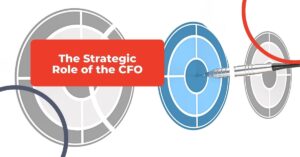The Point of View: Leadership at the Intersection of Vision and Trust
Sep 28, 2022
Vision can’t be achieved without engagement from your team – sometimes we call that “buy-in,” which is shorthand for everybody being on board, in agreement, or at least in agreement to move in the same direction. And for that to happen, people need to trust the vision. This is true when you’re leading a team, leading a company or leading a customer.
Read on as we explore trust and vision in the context of strategic agility and how important a point of view is to serve those strategies. It can feel easier to crunch numbers, rehash revenue and talk tactics – especially in annual planning. Today let’s focus on the importance of becoming visionary, seeking commitment, and being capable of turning vision into action.
Being the Leader
Leadership can be a lonely place. Even the most well-intentioned and selfless leaders often face high stakes and challenging calls, with no shortage of advice from others on how to do things better or differently. Trust is an essential, often overlooked element that can make or break the success of even the most seasoned executive.
Trust has been extensively examined in the context of business relationships and its impact on organizational performance and employee engagement. However, when we think about what makes a great leader, how one trusts—or doesn’t trust—another person is just as important as how they lead others. When we examine great leaders throughout history and across industries, we see that vision without trust often leads to failure.
The Leader’s Point of View
To understand how trust and vision go hand in hand for effective leadership, we first need to understand what a strong leader’s point of view is. For strategic impact, leaders have to put themselves into the shoes of their employees, customers, and partners. They ask questions like “What do they need,” “How do they experience their day-to-day lives,” “What are they hoping to accomplish,” and “How do they make decisions?” The point of view depends on what questions are being asked, when, and by whom. Vision, then, isn’t just seeing the world through one’s own eyes, but seeking to understand through the eyes of others. A leader’s point of view is open, curious, and humble.
The Leader’s Vision
Vision is the art of creating a picture of the future so compelling that it compels others to act. Trust enables leaders’ vision to take root in their employees, partners, and customers. At ProCFO Partners we guide our clients to develop a credible vision – seeing and directing the organization to create attainable if challenging, goals. Here, then, is where trust comes in. In trusting a leader and their vision, stakeholders (like employees, customers, vendors and partners) are betting that the leader and their vision will respect your interests and pursue a mutually beneficial outcome. The extent to which an individual trusts you and your vision directly impacts how willing they are to take a leap of faith and buy into your vision. If they don’t trust you, they are far less likely to bet on your vision and much more likely to retreat into a more familiar and safe way of doing things.
Connecting Vision and Trust to Strategy
When we understand that a leader’s vision only goes as far as the trust that’s placed in it, it’s easier to see the strategic implications. Yet this is where so much annual planning and goals development fails. When annual goals are to increase revenue by 10% – or some other magical number – there is no point of view behind that goal. Therefore there’s no incentive for buy-in! All it takes to remedy this is to shift perspective so that an outcome may include increased revenue.
- Our goal is to reach new communities
- Our goal is to become recognized as a best place to work
- Our goal is to transform how customers think about our product or our company or our industry
These are goals that require vision and can excite buy-in. Putting measurable targets around goals like these is the next important step – what are your key performance indicators? One might be we’ll know it’s working when revenue increases by 10%.
3 Ways Trust Impacts Effective Leadership
Communication
When leaders engage in open and honest communication with their employees, they build trust. When a leader resorts to manipulation or silence instead, they erode trust. Communication is key to building a strong, healthy culture and is one of the best ways to foster trust among team members.
This goes both ways. Developing a culture of communication invites employees to provide feedback, take ownership, and establish mutual trust with each other.
Decision-Making
When a leader has the trust of their team, they are given greater leeway in how they make decisions. When a leader does not have the trust of their team, they are more closely monitored and their decisions are subject to more scrutiny. This is particularly important when navigating challenging situations or defining company strategies that might impact everybody. This connects back to credibility. If every year for the last decade you’ve declared an annual goal of some percent of growth (which, as we’ve explored, already puts employees in a doze), and every year for the last decade you’ve come nowhere near that goal, you haven’t earned trust in your abilities to make decisions about revenue growth.
Team Growth
When team members trust one another, they are likelier to engage in open and honest feedback. This, in turn, promotes growth among team members. Without trust, individuals are less likely to show up authentically and are more likely to hold back not only their feedback but their best efforts.
2 Ways Vision and Trust are Linked with Effective Leadership
Vision-casting
The first way vision and trust are linked with effective leadership is through vision-casting. Leaders must clearly articulate their core beliefs and the future they are working towards. Again, when a leader is able to engage their employees, partners and customers with their vision, they are tapping into the power of trust.
Vision-keeping
The second way vision and trust connect to effective leadership are through vision-keeping. Just as leaders envision a better future, they also commit to seeing that vision come to fruition. When leaders are committed to their vision and ability to withstand challenges, they build trust.
Strategic Impact of Developing Vision
It’s interesting how many people declare themselves “visionaries” because they think they have exciting and original ideas. As we’ve explored, ideas don’t become vision without the trust of those who will carry it out. Keep these thoughts in mind as your leaders, leadership teams, and employees increasingly engage in planning for the future.
Remember, too, that having vision and trust can only develop into strategic meaning when there are systems for following through to action. Seek the insights and counsel of experts like us to help you create that infrastructure and to provide guidance on your vision, goals and strategies.


